Skoda Yeti 1.6 TDI Greenline
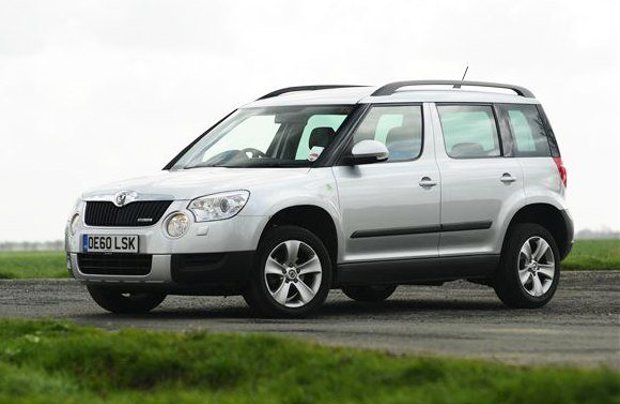
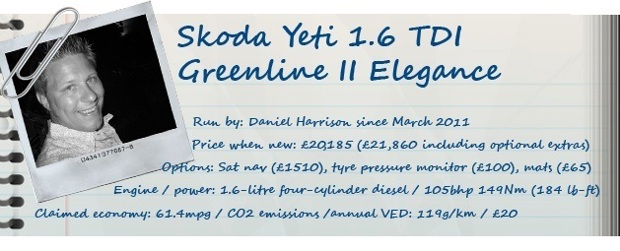
- Why I'm Driving A Yeti
- 10 Things that I'm looking forward to with the Yeti
- Yeti brochure - take a look for yourself
- How does the Greenline's range compare to other Yetis?
- Top Five Skoda Yeti Videos
- The Lowdown on Yeti Greenline II
- Yeti Is An Award Winner
- Yeti as you like it
- Yeti Takes The (Whole) Load
- Goodwood and the 'other' side of Skoda
- The big question: What's the fuel consumption been like?
- Where has the Yeti been?
- A Yeti for all seasons – Come rain or shine, Yeti is prepared
- Skoda Yeti Greenline: What Would You Ask?
Why I'm Driving A Yeti
Yeti is one of the most popular cars on Honestjohn.co.uk. It's regularly in our Top Five Reviews, owners give it the thumbs-up in up and it's a regular talking point in our Back Room Forum. Questions about Skoda's cross-over arrive daily.
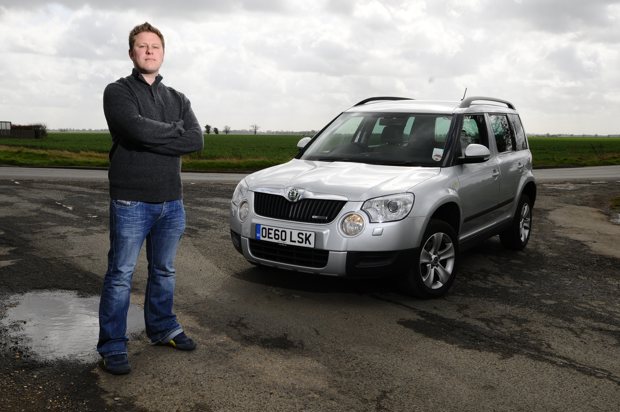
Date: 6 March 2011
So, out of all the cars that I could have chosen to run for six months, why have I opted for the Yeti?
Simple really - you lot love it and I wanted to see what all the fuss was about it. I've driven a number of Yetis in the past on short-term loans, but this will be the first time that I'll have one over a longer period. With excellent practicality, great levels of kit and - so I'm told - top-notch build quality, there's lots to look forward to.
The specific model I'm going for is a recent addition to the Yeti range: the 1.6-litre TDI CR Greenline II. This newcomer boasts low CO2 for cheap road tax (£0 in the first year and £30 after that), but will it live up to the quoted consumption figure of 61.4mp?. Feedback from owners on other Volkswagen Group cars suggests that I'll struggle to match the official Combined figure. We'll see.
In almost every part of the site, someone's got something good to say about this car, from the Back Room Forum to our Owners' reviews - and it's consistently one of our most popular reviews. It's almost a permanent fixture in our Top Five reviews on the homepage.
Owners genuinely seem to love it and, on the whole, have good things to say:
"I swapped my three-year-old 118i SE BMW for this and don't regret it. It's bigger, more comfortable, more economical and seemingly quicker and quieter and nicer on the road than the BMW."
"The Yeti is a small car, that looks large, feels small and is more than spacious enough for five to travel long distances with a full complement of luggage."
"What a great car this is. Superb build quality and great handling for a car this shape. 40 plus to the gallon and much quieter and more civilized than my Altea ever was."
"Although my Yeti only has 110bhp and 2WD, it easily copes with out family of two adults, three kids and two large dogs. Even up steep hills. Solidly built, drives like a hatchback."
Though it's not quite a universal Yeti love-in. One owner complains that his car is "full of rattles", has "average ride and handling" and that the rear seat set-up smacks of "penny-pinching". A one off or more representative of Yeti ownership? I'm about to find out.
Have you got a Yeti? Let me know what you think of yours here.
10 Things that I'm looking forward to with the Yeti
From the potential for eye-opening fuel consumption to the luxury of heated seats, these are the bits most likely to put a smile on my face.

Date: 15 March 2011
My first update was devoted to explaining why the Yeti has been such a hit with users of this site. This one concentrates on what I'm looking forward to about having a Yeti for six months - and my expectations.
1. Fuel Economy from the 1.6-litre diesel engine
This is a Greenline - Skoda's eco sub-brand - and on paper it's capable of more than 61 mpg. How close will we come and how will it stack up with what other owners report with our Real Life Fuel Economy Register? It's also fitted with stop-start technology. Is it easy to live with?
2. Build quality and Reliability
Owners are - on the whole - pleased with Yeti's build quality and report few reliability issues. Our Car-by-Car Breakdown Review highlights this, with just a handful of issues: DSG gearbox hesitancy (my car is manual) and no spare wheel.
I'm hoping that my car will live up to this strong reputation.
3. Stacks of interior space
Whether you're up front or in the back, there's good head, leg and shoulder room for everyone. But I'd like to find out what passengers think when it comes to longer journeys.
4. Foldable and removable seats
Yeti should be one of the most practical cars of its size. The seats not only fold in a number of different configurations, tumble and stow themselves out of the way, but for the largest of loads, they're totally removable. But just how easy are they to take out, how heavy are they and does it substantially add to Yeti's load carrying capability?
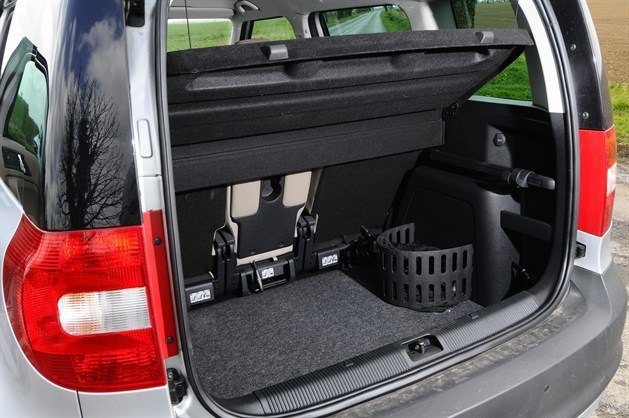
6. Sat Nav and SD card reader
This car is Elegance spec, which means it comes with a whole host of goodies, including full leather upholstery, 16-inch alloy wheels and a four-spoke steering wheel. What's not included is the £1510 satellite navigation system. Pricey, yes, but it's a top-notch system with a large colour touch-screen, multifunctional and comes with built-in SD card compatibility. That means all my music can fit onto a thumbnail-size card and can be carried with me all the time.
7. Heated seats
My time with the Yeti starts in March, so I should still get the benefit. They really take the edge off on a cold morning. Although if the English weather is true to form, I'll get more use out of them than I expect.
8. Hatchback-like driving characteristics
It may be unconventionally styled, but when it comes to how it performs on the road, it's incredibly conventional with decent steering, forgiving ride and good all-round visibility.
9. Long distance cruising ability
A reasonably large fuel tank (55 litres) and the potential for mile-stretching fuel consumption combined with comfy seats, a good ride and cruise control, should make Yeti ideal for longer trips.
10 Skoda jokes
It never fails to amaze me that Skoda jokes are still doing the rounds. It's more than 20 years now since Volkswagen took over and there are some cracking cars in the range. Yet the jokes - which weren’t even funny 10 years ago - still continue. I'm also prepared for plenty of faint praise along the lines of "Not as bad as they were". Curiously, it's usually these sceptics who are the most impressed when they actually get behind the wheel.
Yeti brochure - take a look for yourself
Here's the Skoda Yeti brochure in full to save you traipsing down to the showroom. Browse or download.
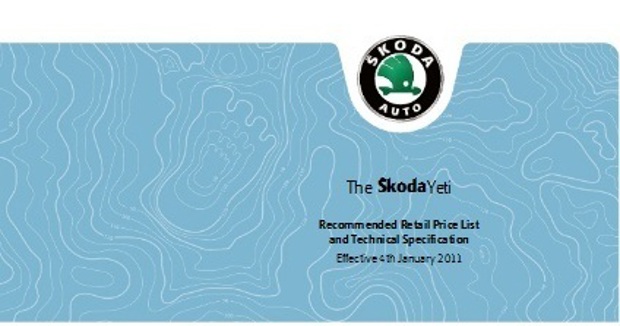
Date: 21 March 2011
How does the Greenline's range compare to other Yetis?
How far can my goody-two-shoes Yeti go? And is it really that much further than other Yetis in the range with different engines?
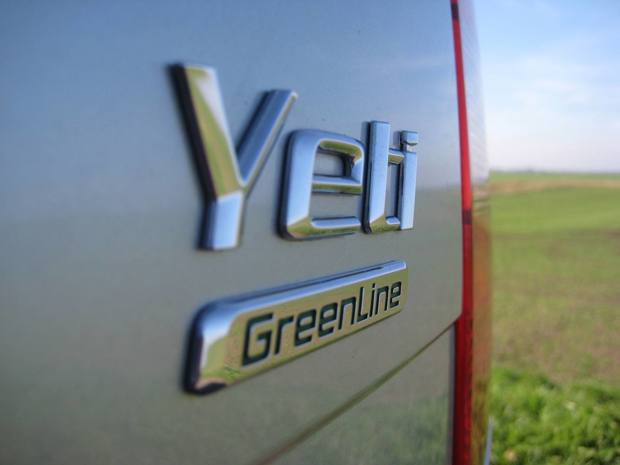
Date: 15 April 2011
The 1.6-litre TDI CR in the Greenline is 9mpg more economical than the next most efficient engine, the 2.0-litre TDI. But what does that mean in terms of miles and how does it stack up to the rest of the range?
All Yetis have a 55 litre fuel tank with the exception of the 1.8 TSI and 2.0 TDI 140, which have a 60-litre tank to stretch the distance between fill ups. Even so, the 1.8 TSI is the model that will see the most forecourt action, needing a fill-up every 460 miles.
Compare the 1.6-litre Greenline to the next most economical model - the 2.0-litre TDI - and you'll find that it will save around £180 per 10,000 miles in diesel (assuming a fuel price of 140p per litre and acheiving the official Combined figure).
I've put together this little graphic to demonstrate the differences.
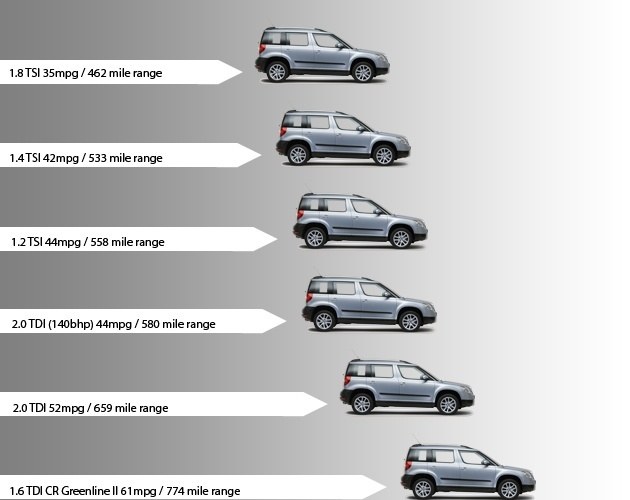
Figures are based on the official Combined fuel consumption.
Top Five Skoda Yeti Videos
From 'that' Top Gear clip to a 'real' Yeti dancing. These are my pick of the Yeti videos on YouTube.

Date: 30 April 2011
This is a collection of my five favourite Yeti clips from YouTube.
1. Top Gear lands a helicopter on top of a Yeti
Clarkson does the things that other Yeti drivers (including me) can't. Don't think I'll be trying this with my Yeti.
2. Honest John's Video Test of the Yeti
No collection of Yeti videos would be complete without this. In this video, HJ is testing the 1.8 TSI 160.
3. Safety first
Yeti has a five-star Euro NCAP crash test rating. This is how it was put to the test.
4. Look mum - no hands!
My car doesn't have this self-park option, but it's still one of Yeti's best party tricks.
5. And just a bit of fun....
Skoda sponsors the Tour de France and took its Yeti mascot along last year...
The Lowdown on Yeti Greenline II
What exactly is behind the Greenline name?
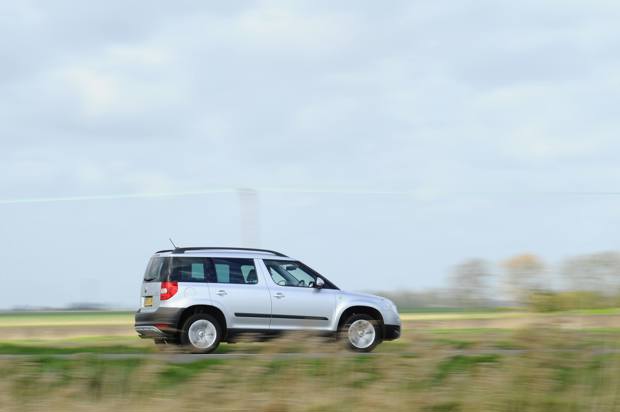
Date: 9 May 2011
The name "Greenline II" is a little misleading on the Yeti. The 'II' part refers to this being Skoda's second generation of Greenline technology. However, unlike the Fabia, Octavia and Superb, there has never been a previous Greenline model.
As with other models within the Volkswagen Group (like the Volkswagen Polo BlueMotion that we're also running), it's a package of fuel-saving technologies. Each makes a small contribution to reducing fuel consumption, with the aim that these small improvements together make a big difference.
The largest contribution comes from the stop/start system. Just a few years back this would have been a real stand-out feature, but in the pursuit of lower CO2 and higher MPG, they're now becoming increasingly common. The Yeti's is much like any other car - it switches off the engine at traffic lights or when it's not needed in heavy traffic. As soon as the driver presses the clutch, the engine fires back into life almost instantly. Skoda claims that this alone reduces CO2 by as 10-20 g/km in urban traffic.
In addition to cutting the engine when it's not needed, the system will convert kinetic energy that would otherwise be wasted back into usable electricity. When the car accelerates or travels at a constant speed, the voltage in the alternator's electronic regulator is reduced to a level below the battery voltage, so the electrical appliances in the car are powered by the energy stored in the battery. The benefit of this is that it reduces the load on the engine and therefore results in lower fuel consumption.
Greenline models are also aerodynamically tuned to maximise efficiency. My Yeti's ride height is 20mm lower than standard models, has lighter alloy wheels and low rolling resistance tyres. Less friction from the tyre means that the car isn't working as hard and therefore saving fuel.
Even I'm encouraged to do my bit from behind the wheel with an indicator (above right in the picture) that shows the ideal gear to be in and tells you if you should be shifting up or down. That's in addition to the instant/average fuel consumption meter, which I'm starting to watch like a hawk.
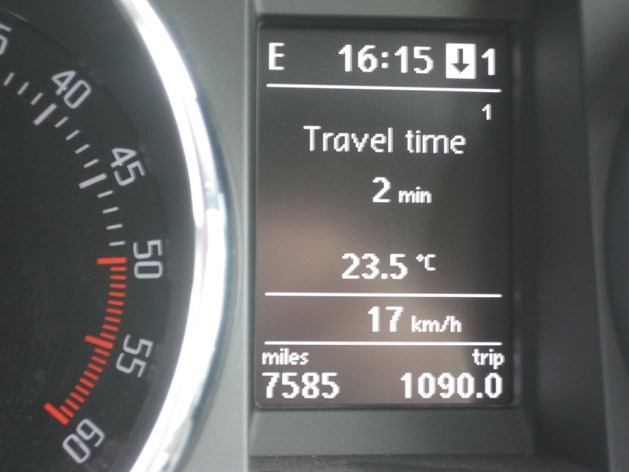
One unexpected area that's been tweaked is the options list: there's less choice than other Yetis. The idea is to keep the weight down. Mine's got sat nav, a tyre pressure monitor and mats. None of which are especialy heavy.
Yeti Is An Award Winner
Yeti bags our 'Car of the Year' Award for being the most searched-for model on honestjohn.co.uk.

Date: 20 May 2011
Our inaugural awards saw the Skoda Yeti walk off with not one, but two awards.
The Honest John awards are different to other honours because they’re not voted for by a panel of judges. Instead they come from the best experts of all: you, our website users. The awards recognise and reward the cars that visitors search for most on the site. Those that have been most popular with our users pick-up the gong.
As I mentioned in my very first report, it's been a smash hit with users of this site and that's reflected in the awards that the Yeti won. At the beginning of the evening it won the crossover category, which meant it was eligible to take the overall Car of the Year prize - which it duly did. In short, the Yeti has been the most popular car on honestjohn.co.uk over the past 12 months.
To pick up the top prize, the Yeti had to fend off some fairly strong competition, including the Audi A1, Ford Mondeo and Volkswagen Golf.

Car of the Year trohpy is presented to Catherine Sleigh, Skoda Head of Press and PR by Honest John
Yeti as you like it
Using the on-board computer, it’s possible to tune the Yeti to exactly how you like it and change everything from how the doors unlock to the daytime running lights.
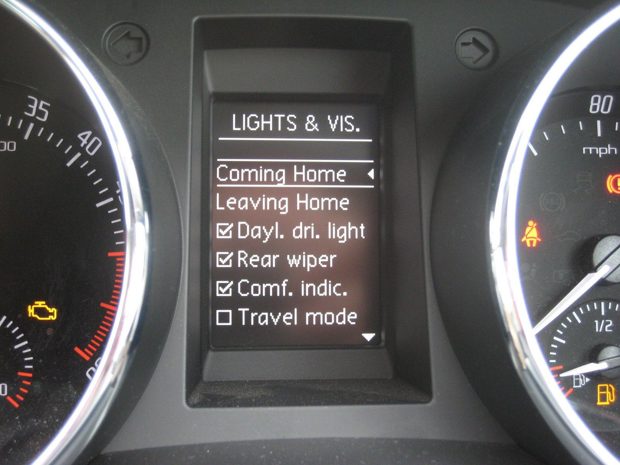
Date: 6 June 2011 | Current Mileage: 6896 | Fuel economy: 54.2mpg
When you live with a car day-in, day-out, it’s often the small things that can really bug you and – if left long enough – really start to grate.
This is what I’ve found after a couple of months with the Yeti.
When I plip the key to unlock the car, it only unlocks the driver's door and not those for the passengers. It sounds like an incredibly minor point, but if you have to separately unlock all the other doors, it’s not long before it becomes very irritating.
Then there's the daytime running lights. They're great in Winter, especially in those dark mornings and afternoons in the first few months of the year. But, in the blazing heat of late Spring/early Summer, are they really needed? With temperatures hitting 25 degrees and not a cloud in the sky, I feel like a bit of a wally driving around with my lights on.
But the answer to both – admittedly trivial - issues lies behind the Yeti’s built-in electronic menu system, accessible via the buttons on the steering wheel. This allows you to finely tune the car to how you want it.
Through the series of simple menus, I was easily able to change how the doors unlock (all doors at once) and switch off the daytime running lights for the Summer. The video of how it's done is below.
That’s not all. The menu system controls a whole range of other functions, from including what is shown on the trip computer (average mpg, average speed, journey time etc), making the clock recognise daylight savings and switching on one-touch indicators and follow-me-home lights. It means that you can have a level of control over the car that would have been unthinkable just a few years ago.
Yeti Takes The (Whole) Load
How does the Yeti cope when it's faced with its biggest load yet?
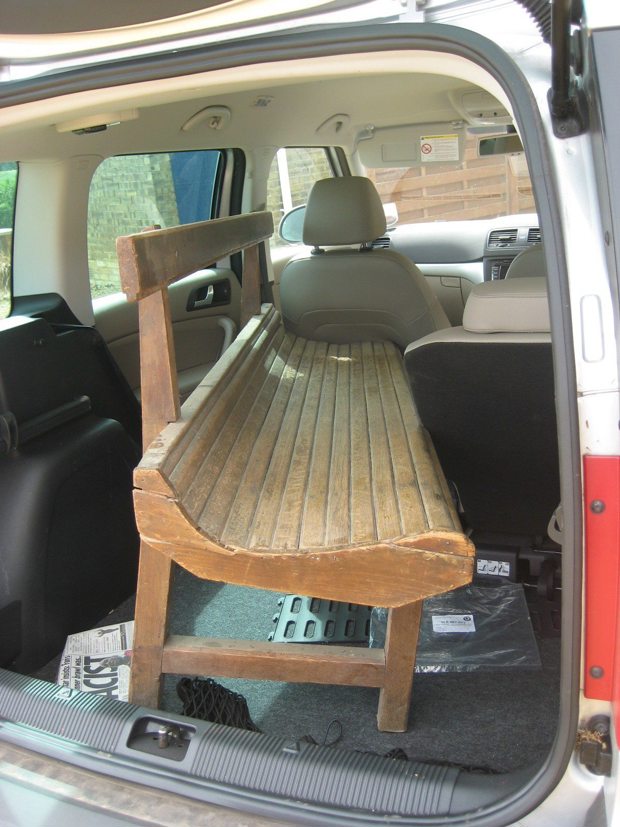
Date: 20 June 2011
One of the biggest benefits of choosing a Yeti over a similar crossover like a Hyundai ix35 or Nissan Qashqai is that the seats are removable, which frees up a huge amount of interior space.
Most of the time it's largely irrelevant as the boot is a good size and shape (and easy to load at that) plus the seats fold, tumble and can be stowed out of the way. The seats split 40/20/40, which means it's easy to transport larger items and passengers at the same time.
But every now and then there's a job that calls for a bit more space. In my case it was bringing back a new bench from a shop in Whitstable. Folding the seats wasn't an option: the size and shape of the bench meant that they needed to come out. I've removed a lot of seats from cars over the years and it's usually surprisingly difficult and often results in scratched arms and bruised hands.
But the Yeti has one of the better seat systems that I've experienced. Once folded and tumbled, the seat is fully removed by releasing two red catches.
The seats aren't light, but neither does it feel like like you're competing in one of the more bizarre challenges in Britain's Strongest Man. A quick check on the scales reveals that they weigh 16.5kg each - about the same as a case (without wheels...). I didn't find the weight and shape of the seats a problem, but if you struggle with your case on holiday, the same may apply to Yeti's seats.
All this got me thinking about all the other practical little touches in the Yeti that almost go unnoticed, but together highlight how much thought has gone into making it more enjoyable to live with.
There's the little plastic clip on the driver's side of the windscreen. It must only cost pence to produce, but is incredibly (and surprisingly) useful for keeping car park tickets in place and in easy view of the warden. A few years back I picked up a parking ticket because the ticket wasn't visible - this puts a stop to that. No wonder it has become one of Skoda's signature features.
Elsewhere, the roof bars add a dash a style and are capable of carrying outsize items, while under the boot floor, there's a handy storage bin. It's just a shame that it comes at the expense of a spare wheel. 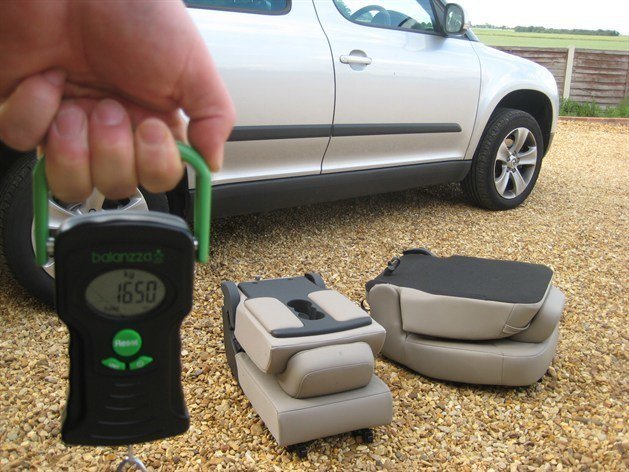
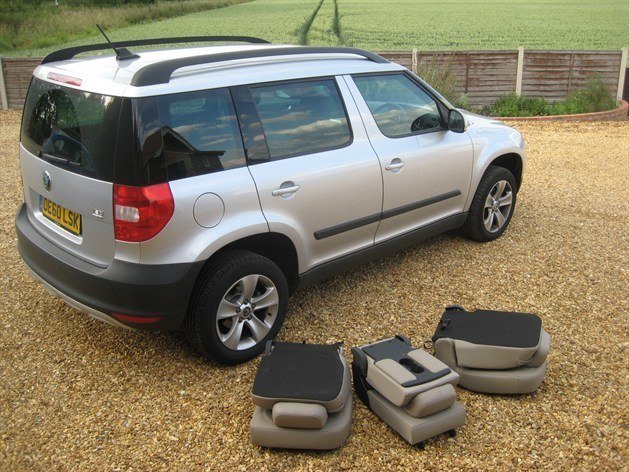
Goodwood and the 'other' side of Skoda
A long trip for Yeti down to the Goodwood Festival of Speed to take a look at the Skoda's 'other' side.

Date: 6 July 2011 | Current Mileage: 7653 | Current fuel economy: 56.1mpg | Other costs: None
Skoda has worked hard over the past 15 years or so re-establish itself as a company that produces well-engineered, sensible and value-for-money cars.
More often than not, it's got that spot-on. None more so than with my very own Yeti.
But there's another side to Skoda that doesn't often get as much coverage - its motorsport division. It perfectly echoes the distinction between its "lovely stuff" Fabia Cake "meaner stuff" Fabia vRS adverts.
So, where better to get the lowdown than at this year's Goodwood Festival of Speed?
Getting down to Goodwood takes about three hours from where I live in Cambridgeshire. It's another opportunity to appreciate what a relaxed cruiser the Yeti makes: comfortable seats, a well-controlled ride and an engine that's perfectly suited to long motorway runs. Economy is good, too. Not quite up to the official figure of 61.4mpg, but at 56.1mpg, it's more than respectable for a car of this size.
What will surprise many - is that Skoda has a surprisingly rich history when it comes to motorsport. This year marks the 110th anniversary of Skoda's involvement in motorsport. So the firm was pulling out all the stops, starting with this huge stand that was bigger than most of the other manufacturers there.

First impressions of the stand are as you'd expect any stand at a Motor Show, with all the firm's main models - from Fabia to Superb on display. But round the back was something altogether more unexpected - a cake factory re-creating Skoda's famous Fabia Cake advert. Bakers worked throughout the day on tasty treats, scale Fabia models in sponge and even an engine. Though the best bit was the free samples on offer - no wonder the queue stretched out of the stand.
After that, visitors were treated to the mean side of Skoda and the 'backstage' area of the Skoda stand moved from lovely to mean. A darkened room contained a caged Fabia vRS, echoing the 'Mean' Fabia vRS adverts. The car would often try and escape from the cage, but its 'handlers' were on-hand to make sure it stayed behind bars.


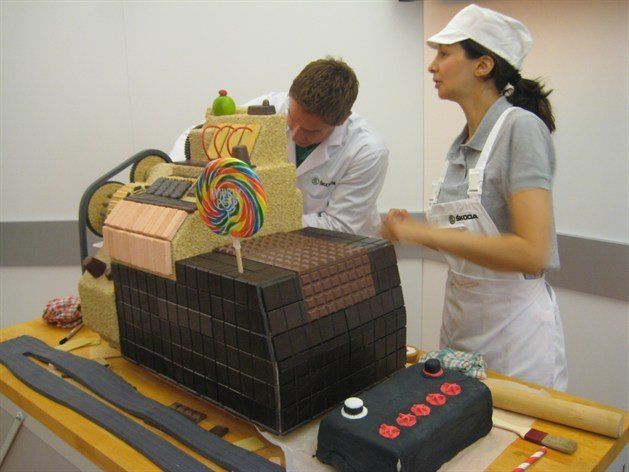
Anyway, back to Motorsport. As well as its stand in the main area of the Goodwood Festival of Speed, Skoda had largely taken over the Rally Stage. The stage was sponsored by Skoda, there was a big display of key models in it motorsport history, including the 1100 OHC (1957), Formula 3 (1964), Spider - Type 720 (1972), 200 RS (1973), 130 LR (1971), 130 RS (1977), Octavia WRC (2002) and Fabia WRC (2003).
In addition, reigning IRC Drivers' champion Juho Hanninen and Skoda UK Motorsport driver Andreas Mikkelsen we at the festival across the weekend, driving the the team's 2011 spec Fabia 2000 on the hill and rally stage.
The entire event left you with no doubt that Skoda sees itself as much as a motorsport compeititor as it does a manufacturer of practical, well-designed cars.
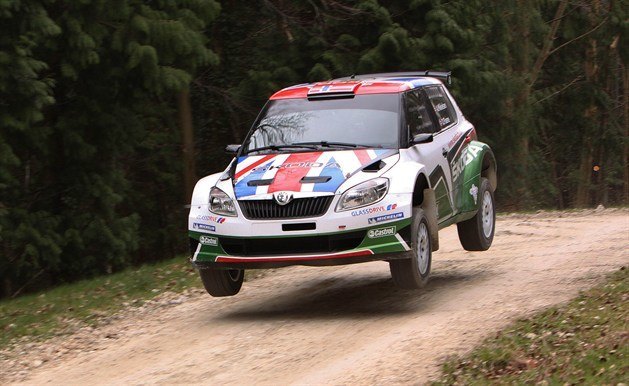
Coincidentally the vRS brand is also celebrating an anniversary this year. It's been on sale in the UK for 10 years and we've got a guide to all the models here.
The big question: What's the fuel consumption been like?
Does it live up to the promised 61.4mpg?
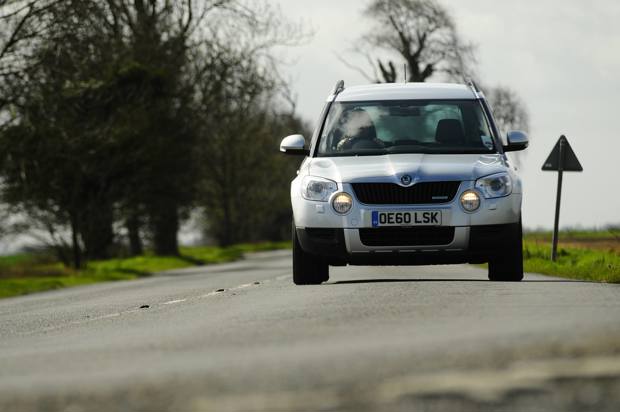
Date: 1 August 2011 | Mileage: 7821 | Current fuel economy: 56.3mpg | Other costs: None
At the start of the year, we launched our Real Life Fuel Economy Register to build up a picture of what kind of consumption you're getting from your cars.
So I've been itching to find out what the Yeti Greenline does over the course of several months and some varied driving.
In fact, this Yeti has been all over the pace, as my map shows. From Liverpool and Manchester to Goodwood and Royal Tunbridge Wells. But it's not all been motorways. Living in a rural area has meant lots of B-Road blasts too and there's even been a bit of light off-roading thrown-in for good measure, too. In addition, there have been varied loads, warm days with the air con on and different numbers of passengers.
Over the course of the past four months, I've been achieving 56mpg overall, with motorway driving coming in at around 60mpg.
Filling up makes a big difference. Putting 55 litres of diesel into the tank adds around 45kg of weight, so all the time you're filled to the brim, you're carrying the equivalent of two very large suitcases around with you. In fact, as one of my previous updates shows, it's actually more weight than the back seats.
It has a serious impact on fuel consumption. Even with the lightest of light right feet, it knocks between 7-10mpg off what I can achieve when the Yeti has between a quarter and half a tank of fuel. So that means instead of achieving 56mpg, I tend to get between 48 and 50mpg, depending on conditions. That means the first half of full tank could actually be costing me between 50 and 60 miles of range. At a stroke, that cuts my theoretical range down from 774 miles to to 714 miles
The actual range that I've been seeing from the Yeti is around the 650 miles mark. Some way off the 774 that it can theoretically do, based on the official fuel consumption figures, but still enough to get it from London to Wick, on the furthest tip of Scotland.
I thought I was doing rather well with an average of 56mpg, which is just 5mpg off the official Combined figure of 61.4mpg. But then I took a look at the entries in our Real Life Fuel Consumption Register for Yeti. Other owners seem to doing a lot better and beating the official figures by some way. I'll see if I can up my game in the coming weeks and months and improve as the car breaks through the 8000-mile barrier.
Where has the Yeti been?
My map gives details of what I've been up to in the Yeti and where in the UK it has been.
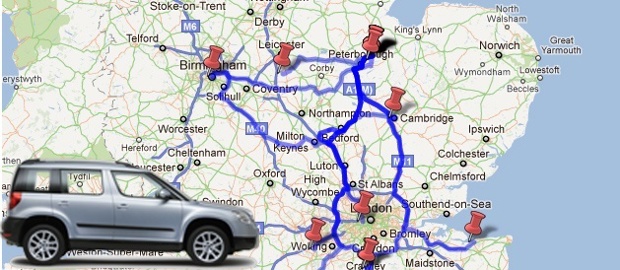
Date: 9 September 2011
View Yeti Long Termer in a larger map
A Yeti for all seasons – Come rain or shine, Yeti is prepared
Summer or Winter, day or night, Yeti continues to prove itself.
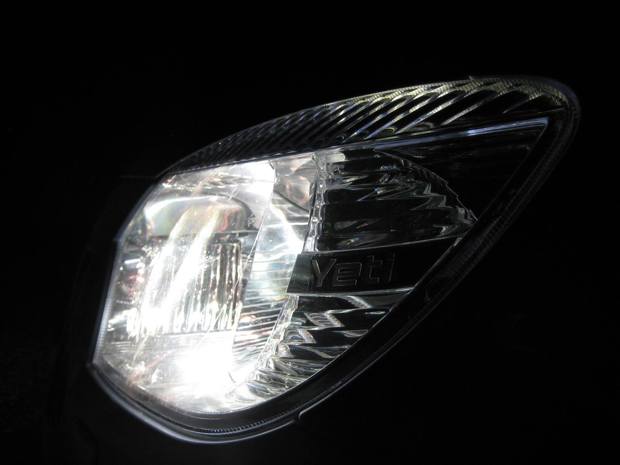
Date: 8 October 2011
We weren’t blessed with the warmest of Summers this year, but the upside to that is that it showed off some of Yeti’s strong points.
August saw its fair share of outside events, from proms to festivals, and as is typical at these events there’s always a good dousing of rain. With that comes those muddy, boggy fields that double as car parks in the Summer – and the worry that you’re going to be left stuck-in-the-mud when you come to leave.
But that’s not been the case with my Yeti. It may not be one of the models fitted with four-wheel drive (that would have a significant impact on emissions, fuel economy and therefore Road Tax), but with its raised ride height and chunky tyres, it’s still good enough to save you from the indignity of being pulled out of the mud by a tractor. In fact, I reckon for many buyers, the two-wheel drive Yeti is just the job and there’s no need to opt for one with four-wheel drive.
Once again the Yeti proved how practical it is. We’ve come to take the large, easy-to-load boot for granted – it swallows almost any load and, even with three in the back, there’s still loads of room for luggage. When it comes to camping equipment, it once again takes the lot with ease.
This Yeti has now been with me since March, coinciding with the longer nights of the Summer. Now that they’re drawing in, previously hidden features have begun to grab my attention as I’m driving the car in the dark a lot more. The ‘guide-me-home’ headlights that stay on for an extra 30 seconds to light up the path to the door are especially useful, while the ‘Puddle Lights’ that are built into the wing mirrors and illuminate the floor below are another minor detail, but one that’s incredibly practical – who want to open the door and step into a large pool of water?
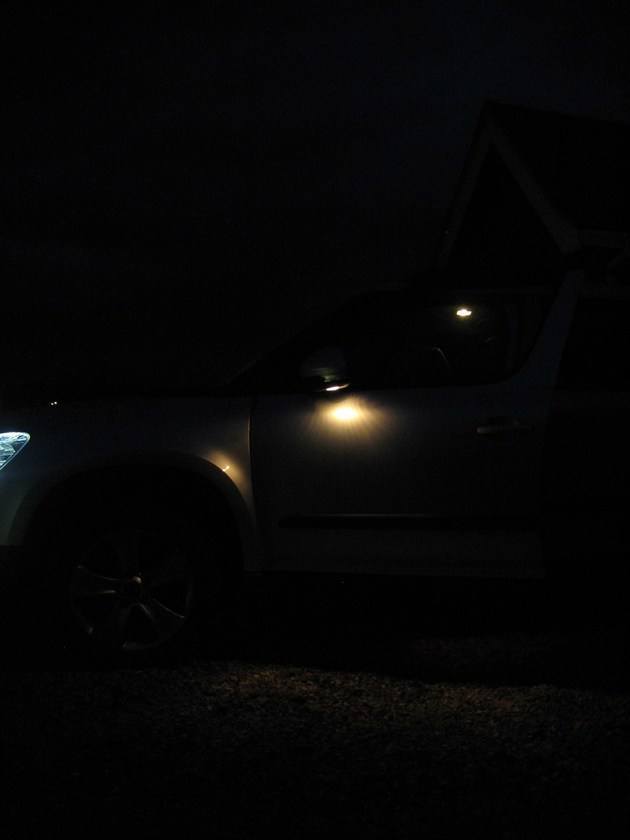
Skoda Yeti Greenline: What Would You Ask?
Ask me anything you like about the Yeti Greenline.
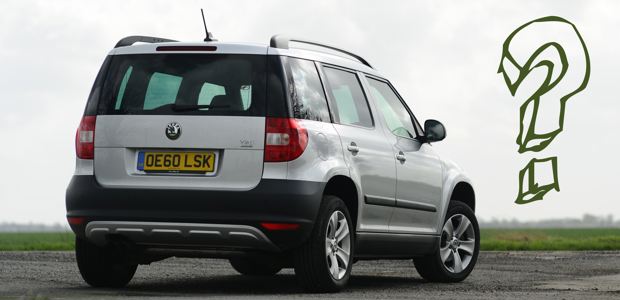
Date: 26 October 2011
After more than six months living with the Skoda Yeti Greenline, I'm opening the floor to you. Tell me what you want to know and I'll do my best to answer.
